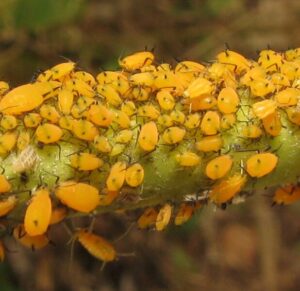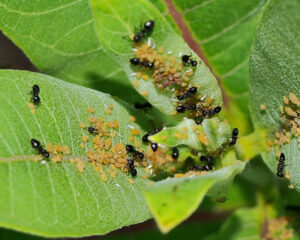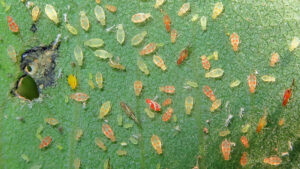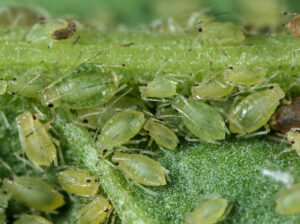Milkweed is a popular choice in urban landscapes as more citizens engage with monarch conservation efforts and strive to maintain pollinator-friendly landscapes. This past month I have seen numerous images of aphids found on milkweed plants from all over the state. Homeowners are concerned that the infestation will negatively affect the monarch butterflies that rely on milkweed as a food source. Aphids reproduce rapidly and can cause sooty mold outbreaks, and their feeding distorts the new plant growth. Are these insects harmful to monarchs, and what (if anything) should be done about them?
Species of aphids on milkweed
There are several species of aphid that are frequently found on milkweed. Oleander aphids (Aphis nerii) (Fig. 1) are a very common generalist species that feeds on over 50 plant species, including milkweed, pimpernel, and oleander. All of the images I have seen from homeowners lately have been oleander aphids. Dogwood-milkweed aphid (Aphis asclepiadis) (Fig. 2) is another aphid in our region which feeds on several species in the genus Asclepias. Common Milkweed aphid (Myzocallis asclepiadis) (Fig. 3) feeds exclusively on Asclepias syriaca, or common milkweed. The peach-potato aphid (Myzus persicae) (Fig. 4) also sometimes colonizes milkweed.
- Fig. 1: Aphis nerii, Oleander aphid. Notice the bright yellow color and hind legs are completely black. Image by Beatriz Moisset.
- Fig. 2: Aphis asclepiadis, Dogwood-milkweed aphid. Slightly duller yellow than Oleander aphids, and the hind leg is not completely black. They are often attended by ants. Image by Ken Potter.
- Fig. 3: Myzocallis asclepiadis, Common Milkweed aphid. Pale green to red in color, or pale green with bright red spots. All adult aphids are winged. Image by Seth Ausubel.
- Fig. 4: Myzus persicae, peach-potato aphid. Green-yellow or red in color with pale legs. Winged adults have a black head and thorax and black spots on the legs. Image by Gilles San Martin.
Do aphids harm monarchs?
Research suggests that the answer to this question is different depending on the species of milkweed. Ali and Agrawal (2014) showed that oleander aphid presence on A. syriaca actually benefits monarchs by impairing the plant defenses, and monarch larvae grew 38% faster on aphid-infested plants. This same study showed no interactions between oleander aphids and monarchs on A. tuberosa (butterfly weed). In contrast, Mach et al. (2023) found that oleander aphid presence negatively affected monarch oviposition and larval feeding on A. curassavica (tropical milkweed). Thus, the effect of aphid infestations on monarch fitness varies between different species of milkweed.
Management
It is not recommended to use any chemicals to control aphids on milkweeds. Chemical controls will likely do more harm to the monarch caterpillars than the aphids. For severe infestations, aphids can be sprayed with insecticide soap or dislodged manually with a stream of water to reduce their population. Avoid pruning the plants since this will induce new growth and encourage aphid colonization. If left alone, natural predators such as lady beetles and parasitoid wasps will move in and manage aphids sufficiently.
Citations
- Ali, JG and Agrawal, AA (2014) Asymmetry of plant-mediated interactions between specialist aphids and caterpillars on two milkweeds. Functional Ecology 28: 1404–1412. doi: 10.1111/1365-2435.12271
- Mach BM, Long W, Daniels JC, Dale AG (2023) Aphid infestations reduce monarch butterfly colonization, herbivory, and growth on ornamental milkweed. PLoS ONE 18(7): e0288407. https://doi.org/10.1371/journal.pone.0288407



